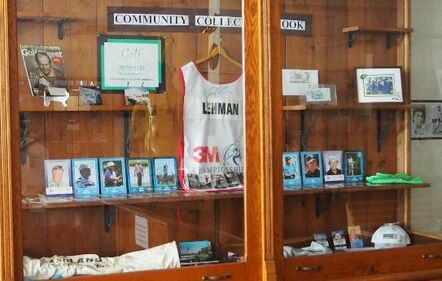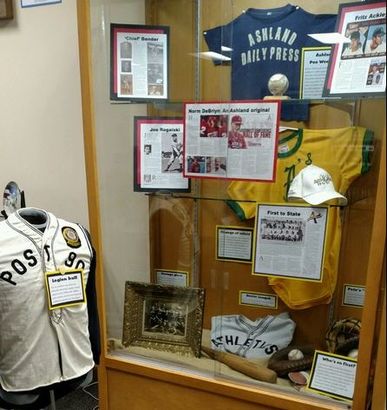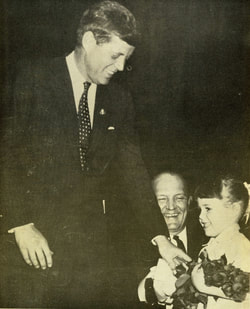On Display at the Museum!
THE MUSEUM GIFT SHOP
Unique Items
The Museum Gift Shop offers a wide variety of items that are not always available at other shops in the Ashland area. Beautiful jewelry at realistic prices, pictures of local area sites, hand carved items, locally made products and cards. Also, a variety of new and used books many about the history of the Chequamegon Bay area.

Norman Rockwell Collection
The beautiful plates inspired by the pictures painted by Norman Rockwell are in our Community Nook Display Case. This collection has been donated to the Ashland Museum by Sam and Karolyn Solberg.
The beautiful plates inspired by the pictures painted by Norman Rockwell are in our Community Nook Display Case. This collection has been donated to the Ashland Museum by Sam and Karolyn Solberg.
Women in the Military

Pump it up!
This beautiful pump organ is on display at the Ashland Historical Society Museum. The organ was donated to the Museum in memory of Michael A. and Mary Ann Kehoe. When Mike and Mary Ann Kehoe purchased the County Poor Farm at 1319 Beaser Avenue in 1962, this pump organ was in the lobby. When the Kehoes retired 25 years later, they moved the organ to their home and had it refinished.
This beautiful pump organ is on display at the Ashland Historical Society Museum. The organ was donated to the Museum in memory of Michael A. and Mary Ann Kehoe. When Mike and Mary Ann Kehoe purchased the County Poor Farm at 1319 Beaser Avenue in 1962, this pump organ was in the lobby. When the Kehoes retired 25 years later, they moved the organ to their home and had it refinished.
History Remembered!This display brings back memories of railroad trains and the rail cars, a city by a lake, a lighthouse, a paper mill and the old billboard signs. Although not a replica of Ashland, it reminds us of some of those cherished memories of times past in Ashland. To see this exhibit visit the Museum at 216 Main Street West and bring the kids along. |
Lake Shore Exhibit

The late Harvey Hadland created wooden replicas of the ore freighters. Built to scale, his attention to detail was precise, reflecting his interest in the freighters that were an everyday sight along the city’s lakefront during the early to middle 20th Century.
Hadland made models of ore freighters such as the Ralph Budd, Belle River, and Benson Ford, built in 1924 by the Ford Motor Co. to transport iron ore across the Ashland and the Great Lakes for steel to build the fledgling automobile industry.
Clifford Hadland has donated five of his brother’s handmade model ore boats, one tug boat, two compasses, and two paintings to the Ashland Historical Society Museum in memory of Harvey Hadland.
Hadland made models of ore freighters such as the Ralph Budd, Belle River, and Benson Ford, built in 1924 by the Ford Motor Co. to transport iron ore across the Ashland and the Great Lakes for steel to build the fledgling automobile industry.
Clifford Hadland has donated five of his brother’s handmade model ore boats, one tug boat, two compasses, and two paintings to the Ashland Historical Society Museum in memory of Harvey Hadland.
Past Ashland Historical Society Museum Displays

lt's Bar Time!
Tavern-keeping has long been one of the most thriving businesses in Ashland's history. With that in mind, the Ashland Historical Society Museum celebrates this proud tradition with a look back at some of the great old watering holes that have served as gathering places for our citizens.
Tavern-keeping has long been one of the most thriving businesses in Ashland's history. With that in mind, the Ashland Historical Society Museum celebrates this proud tradition with a look back at some of the great old watering holes that have served as gathering places for our citizens.

"Over there" ...
World War I
- A display of World War I memorabilia and photos was created by Museum volunteer Jason Janecek, features medals won by lifelong Ashland resident John H. Crowley, a U.S. Army sergeant who was awarded the Silver Star for gallantry in action.
More than five generations of Ashland doctors, nurses, and medical equipment were on display in an early healers exhibit last winter at the Ashland Historical Society Museum.

Let's play 18
This impressive array of photos, autographs and memorabilia from the world of professional golf was on display in the Community Collection Nook on temporary loan to the Museum from Ashland resident Al Lundquist during the summer of 2018.
This impressive array of photos, autographs and memorabilia from the world of professional golf was on display in the Community Collection Nook on temporary loan to the Museum from Ashland resident Al Lundquist during the summer of 2018.
Beach Glass
This beautiful collection of beach glass was picked by Ashland resident Sammi Beauregard who picked the glass over a three year period, between the Soo Line ore dock and the boathouses on Chequamegon Bay.
Remembering our 15!
A past exhibit at the Ashland Historical Society Museum featured a mini-display of The Wisconsin Remembers Exhibit, which puts a face to every Wisconsin name listed on the Vietnam Veterans Memorial Wall in Washington, D.C.
The Museum's mini display offered pictures and bios of the 15 men from Ashland and Bayfield Counties who lost their lives in Vietnam, and serves as a subset of the 1,161 Wisconsinites officially listed on the wall. The full Wisconsin exhibit was held at the Northern Great Lakes Visitor Center from September 23-25, 2017.
The Museum's mini display offered pictures and bios of the 15 men from Ashland and Bayfield Counties who lost their lives in Vietnam, and serves as a subset of the 1,161 Wisconsinites officially listed on the wall. The full Wisconsin exhibit was held at the Northern Great Lakes Visitor Center from September 23-25, 2017.
Celebrating Northland College
Siennah Schueller, Northland College intern with the Ashland Historical Society Museum, stands behind part of the exhibit that celebrated Northland’s 125th anniversary. Northland was founded in 1892 as North Wisconsin Academy.
|
Play Ball!
A mini-history of Ashland baseball. Features of the exhibit included Ashland native and legendary college baseball coach Norm DeBriyn; Joe Rogalski and Ray Callahan, former major leaguers born in Ashland; Hall of Fame pitcher, Chief Bender; the 1967 Ashland High School team, the first to make it to the State Baseball Tournament; and a photo of Ashland's 1889 city team. Also included in the exhibit are uniforms and equipment from Ashland's Pee Wee, Little and Senior leagues. |
Kennedy in Ashland: March of 1960
Former First Lady Eleanor Roosevelt visits Ashland in October of 1956
Hats off to 'Mrs. B'
Astrid Berthiaume, known to most as “Mrs. B” during her 48-year teaching career, was also “The Hat Lady,” collecting more than 500 hats in her lifetime.
The Wreck of The Edmund Fitzgerald

All aboard!
A small part of the collection of railroad artifacts and memorabilia owned by Ashland’s Bob Pufall was on display in the Community Collection Nook of the Ashland Historical Society Museum.
A small part of the collection of railroad artifacts and memorabilia owned by Ashland’s Bob Pufall was on display in the Community Collection Nook of the Ashland Historical Society Museum.
Some places to buy ice cream in bygone days of Ashland
It was fashion: 1900s to the 1960s
Communication

Communication is the critical link between man and his world. The subject of an exhibit at the museum is communication. From the bright red dial phone to the old-style typewriter, this display opens a window into historic ways of communication.
The invention of movable type is considered one of man’s greatest achievements, but the advent of cell phones and texting blows that out of the water. In between these two great avenues of communication we include such ways to communicate as the telegraph, the telephone, signing, the personal typewriter, dictation and written letters. Each of the methods of communication played a vital role in the everyday lives of folks all over the world, providing both information and careers. Although letters are not as widely used anymore, with all the electronic ways to communicate, it is still exciting to receive a written letter through the mail and to anticipate its contents.
Some of you may have received the same graduation gift before going off to school--your very own typewriter. These days they are obsolete, to say the least, with computers, iPads and other tablets taking their place. During World War II, a telegraph could bring devastating news to many homes, but at times, good news, too. Bradle’s Store near Our Lady of the Lake Church and School was the designated spot for sending and receiving telegrams.
Dr. George Harrison, the 1st, was instrumental in bringing the first power and light company to Ashland, which paved the way for telephones. The Wisconsin Telephone Co. building was on the corner of Second Street and Second Avenue East. The telephone company provided many jobs for people in the area, from linemen to operators and other jobs in between for such old timers like George Marker, Bernice Heiber, Neil Walworth, Ralph Korbein and Arnie Mathisen.
Three schools provided business education in the city of Ashland. The Gordon School of Business was established in 1892 and was located at 210 Prentice Avenue until it closed 1943. The Vocational School, (now Wisconsin Indianhead Technical College) was established in 1920 and Northland College, established in 1892.
How many of you can remember the communication games of your youth? Connecting two tin cans by string or wire to “call” each other from a distance; playing the telephone game where your sentence was repeated by friends in a circle many times to see if the original sentence stayed the same; creating secret codes for writing messages and many more ways for fun in the “old days”.
The invention of movable type is considered one of man’s greatest achievements, but the advent of cell phones and texting blows that out of the water. In between these two great avenues of communication we include such ways to communicate as the telegraph, the telephone, signing, the personal typewriter, dictation and written letters. Each of the methods of communication played a vital role in the everyday lives of folks all over the world, providing both information and careers. Although letters are not as widely used anymore, with all the electronic ways to communicate, it is still exciting to receive a written letter through the mail and to anticipate its contents.
Some of you may have received the same graduation gift before going off to school--your very own typewriter. These days they are obsolete, to say the least, with computers, iPads and other tablets taking their place. During World War II, a telegraph could bring devastating news to many homes, but at times, good news, too. Bradle’s Store near Our Lady of the Lake Church and School was the designated spot for sending and receiving telegrams.
Dr. George Harrison, the 1st, was instrumental in bringing the first power and light company to Ashland, which paved the way for telephones. The Wisconsin Telephone Co. building was on the corner of Second Street and Second Avenue East. The telephone company provided many jobs for people in the area, from linemen to operators and other jobs in between for such old timers like George Marker, Bernice Heiber, Neil Walworth, Ralph Korbein and Arnie Mathisen.
Three schools provided business education in the city of Ashland. The Gordon School of Business was established in 1892 and was located at 210 Prentice Avenue until it closed 1943. The Vocational School, (now Wisconsin Indianhead Technical College) was established in 1920 and Northland College, established in 1892.
How many of you can remember the communication games of your youth? Connecting two tin cans by string or wire to “call” each other from a distance; playing the telephone game where your sentence was repeated by friends in a circle many times to see if the original sentence stayed the same; creating secret codes for writing messages and many more ways for fun in the “old days”.
Ore Dock Display |
The ore dock display is a staple feature of Ashland’s past and of the history contained in this region. The five ore docks that once lined Ashland’s shore of Chequamegon Bay are highlighted throughout the display, which presents information on all of the different lines and companies that built, maintained, and ran the docks. The Soo Line Ore Dock is shown in photos and paintings, and the exhibit allows visitors to write down and share their favorite memories of this dock. On display are models of the ore freighters, including the Ralph Budd, the Belle River, and the Benson Ford created by Harvey Hadland, as well as other model boats which were given to the museum for the display. There are dioramas detailing the processes that took place at the mill, the pulp hoist, and at the docks for both the mining and the lumber industries. Also housed in the display are aerial shots of the docks, photos during construction and demolition, and newspaper articles describing accidents that occurred with workers. Several whistles, compasses, and other pieces used on the freighters and ore docks are also included in the display.
|


































